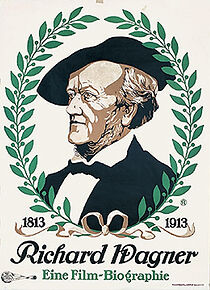|
At the age of eight, Wagner plays for his dying step-father. When sixteen he studies with Cantor Weinlig. Then follows a period of dissipation. In 1834 he is offered the position of conductor of the Lauchstadt Opera. He first refuses, but, meeting the leading actress, Wilhelmina Planer, he accepts. In 1836 he is conductor at Konigsherg, and marries “Minna.” They quarrel over his extravagance, but are reconciled in time to greet their friends. In 1838 Wagner is conductor at Riga. While rehearsing he is interrupted by his creditors. Assisted by his friend Moller, he eludes them and the Cossack sentries. He reaches a German seaport, where he boards a small sailing vessel and starts for Paris. During the voyage a terrific storm inspires “The Flying Dutchman.” Arriving in Paris he calls upon Meyerbeer and plays parts of “Rienzi” for him. Meyerbeer gives him letters, among them one to the director of the Paris Opera, who, however, reuses to do anything. He calls upon Liszt, who receives him cordially. Minna is disheartened by his failures, but when things are at the worst, he receives a letter from his brother-in-law calling him to Dresden to produce “Rienzi.” “Rienzi” is successfully produced in 1842, and at the age of 30 Wagner is appointed conductor of the Dresden Opera. He again extravagantly furnishes a home. “The Flying Dutchman” is produced and fails. His creditors become urgent, and when “Tannhauser” falls he is dismissed. Bakunin, a Russian revolutionary, persuades him to join the uprising of 1849. He addresses a meeting and arouses great enthusiasm. The insurrection is quelled and Wagner is forced to flee, being aided by Liszt. He goes to Zurich. He reads the libretto of the “Niebelung’s Ring” for a party of friends, among them being von Bulow and his wife, Cosima, the daughter of Liszt. During the reading, scenes from the “Ring” are shown, inspired by the beautiful Fran Wesendonck. Wagner begins “Tristan and Isolde.” Their friendship arouses Minna’s jealousy and, after a quarrel, they separate. King Ludwig of Bavaria, sends for Wagner and establishes him in Munich in the Spring of 1864. The King’s ministers seek Wagner’s assistance, which he refuses. They manage to have him sent away. He goes to Lucerne, where the King visits him during the composition of “The Master-singers,” Cosima, having separated from von Bulow, comes to Wagner and they are married in 1870. Bright days come: the Festspielhaus and Wahnfried are built at Bayreuth. Kaiser Wilhelm attends the opening performance. Ludwig receives Wagner and his family. “Parsifal” is produced July 26, 1882. February 13, 1883, Wagner dies in Venice. The last picture shows the dead master surrounded by the characters he had created. |
||
| Ratings: | IMDB: 6.3/10 | |
| Released: | November 20, 1913 | |
| Runtime: | 110 min | |
| Genres: | Drama History Biography | |
| Countries: | Germany | |
| Companies: | Messter Film Berlin Messters Projektion GmbH | |
| Cast: | Olga Engl Manny Ziener Giuseppe Becce | |
| Crew: | William Wauer Carl Froelich | |



Alien : Pretty cool so far. Lots of action. Plus Ronny Chiennnnng!